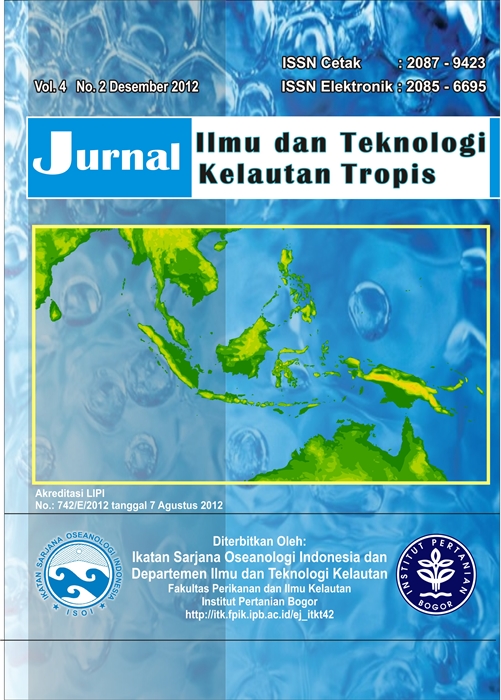NUTRIENT PHOSPHATE, NITRATE AND SILICATE DISTRIBUTION OF NATUNA ARCHIPELAGO WATERS
Abstract
Research on phosphate, nitrate and silicate distributions of Natuna ArchipelagoWaters was conducted using RV Baruna Jaya VIII in April 2011. Concentration of phosphate, nitrate and silicate were analyses by Spectrophotometry. The purpose of the study was to assess the distribution of nutrients as fertility indicator of marine life. The results showed that the phosphate concentration at surface layer of Subi, Bunguran, and Laut islands ranged from 0,04 to 0,22 µg A/l, 0,04 to 0,18 µg A/l and from 0,04 to 0,13 µg A/l, with average 0,11 µgA/l, 0,08 µgA/l and 0,07 µg A/l, respectivelly. Concentration of nitrate ranged from 0,31 to 4,90 µg A/l, 0,23 to 2,29 µg A/l and from 0,14 to 0,32 µg A/l with average of 90 µgA/l, 0,78 µg A/l and 0,22 µg A/l, respectivelly. Silicate concentration ranged from 2,97 to 5,35 µg A/l, 2,28 to 4,85 µg A/l and from 2,28 to 3,57 µg A/l with average 4,49 µgA/l, 3,62 µg A/l and 3,02 µg A/l,respectivelly. While phosphate concentration at bottom layer of Subi, Bunguran and Laut islands ranged from 0,04-0,27 µg A/l, 0,04-0,31 µg A/l and 0,09-0,22µg A/l,, with average 0,13 µgA/l, 0,13 µgA/l dan 0,12, µg A/l respectivelly. Concentration of nitrate ranged from 2,59-5,61µg A/l, 0,73-4,75 µg A/l and 2,06-3,03 µg A/l with average 2,85 µgA/l, 3,14 µg A/l and 2,49 µg A/ respectivelly. Silicate concentration in Subi, Bunguran and Laut Islands ranged from 4,46-6,21 µg A/l, 3,20-5,84 µg A/l dan 3,07-4,66 µg A/l with average 5,323,73 µgA/l, 4,74 µg A/l dan 3,73 µg A/l. In general concentration of those nutrient of Natuna Archipelago waters was still within the Standard Quality set by the Ministery of Environment (KMNLH).
Keywords: nutrient, phosphate, nitrate, silicate, Natuna Archipelago waters.
Authors
The author submitting the manuscript must understand and agree that the copyright of the article manuscript must be submitted/transferred to the Jurnal Ilmu dan Teknologi Kelautan Tropis. This work is licensed under the Creative Commons Attribution-ShareAlike 4.0 (CC BY-SA) International License in which the Author and Reader can copy and redistribute the material in any media or format, and remix, modify and build material for any purpose, but they must provide appropriate credit (citing articles or content), provide a link to the license, and indicate whether there is a change. If you mix, change, or create material, you must distribute your contribution under the same license as the original.

